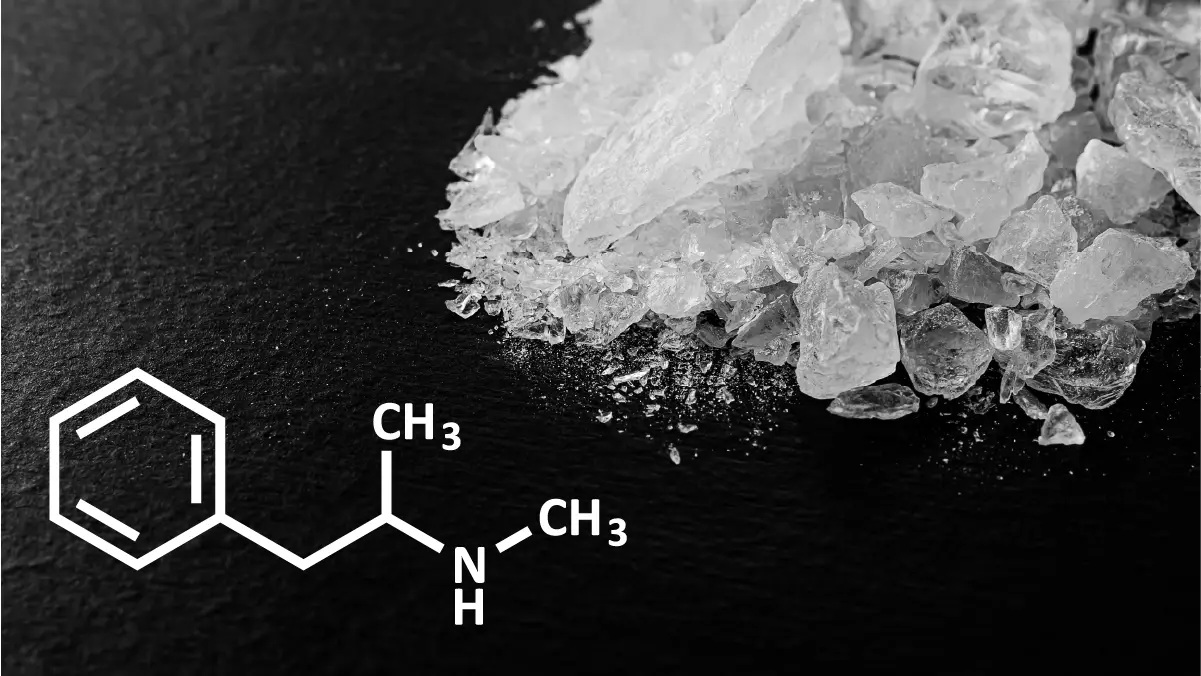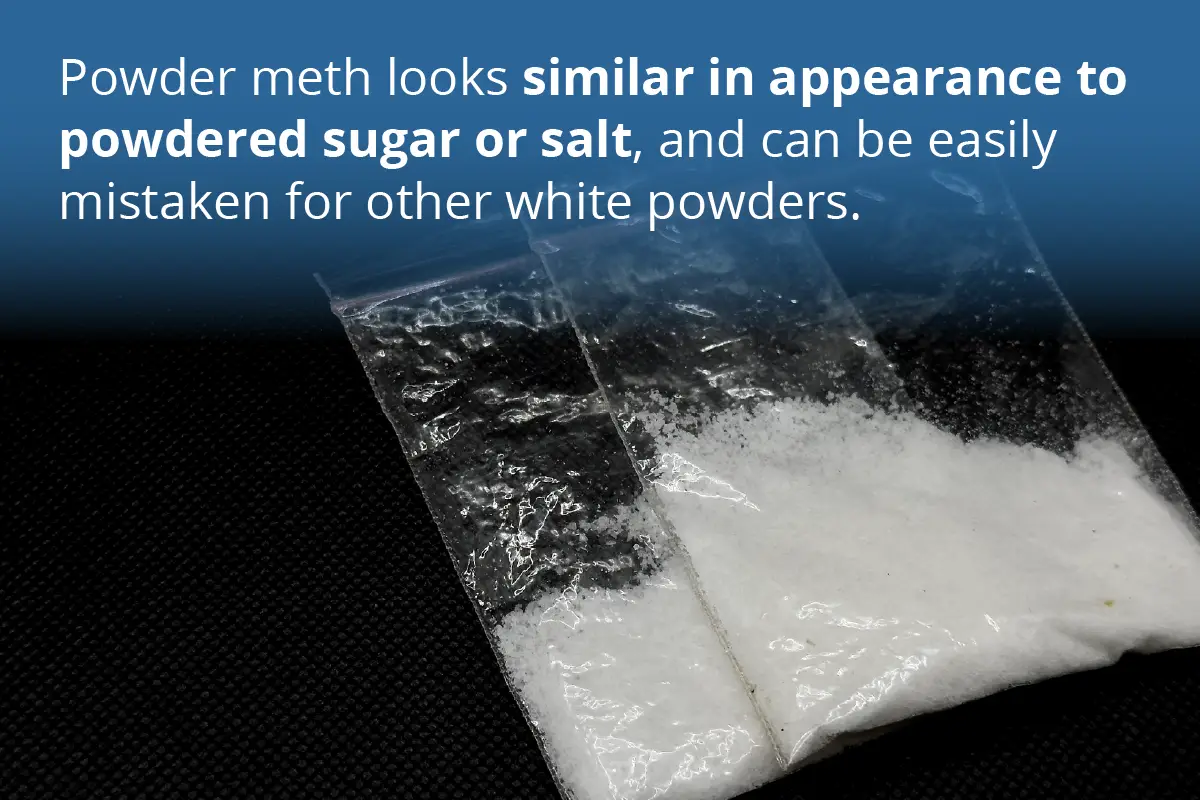
Methamphetamine, commonly known as meth, belongs to a class of drugs known as amphetamine. Many people wonder, what does meth look like? Meth typically appears as a crystalline powder or in crystalline form, resembling small rocks. Its appearance can differ depending on factors like purity and manufacturing methods.
When consumed, meth increases the release of neurotransmitters such as dopamine, norepinephrine, and serotonin in the brain. It can increase euphoria and energy, enhancing focus and mental alertness.
Meth is typically produced in illegal forms in clandestine laboratories using a variety of toxic chemicals and solvents. Chronic meth abuse can have devastating effects on both physical and mental health, making it a dangerous drug.

Each form of meth is used differently, and its appearance can vary widely, affecting how it is consumed and distributed. These are major forms of meth:
One of the defining characteristics of crystal meth is its crystalline form. Crystal meth usually appears as clear or bluish-white rocks resembling glass fragments or shiny rocks, hence why this form is usually called meth rocks. It can vary in size and shape, ranging from small shards to larger chunks.
On the streets, crystal meth goes by a variety of names, reflecting its widespread use and cultural significance within certain communities. Some of the common street names for crystal meth include “ice,” “crystal,” “crystal glass,” “Tina,” “crank,” “chalk,” and “glass.”
Visually, the effects of crystal meth on individuals who use it can be striking. Chronic use of meth often leads to severe physical and psychological deterioration, including rapid weight loss, tooth decay, skin sores, and a generally unhealthy appearance.
Powder meth is a type of drug that comes in a fine, white, or sometimes slightly off-white powder form of meth. It’s a powerful stimulant that speeds up the messages between the brain and the body. On the streets, powder meth is known by various names, including “crystal,” “crystal meth,” “ice,” and “Tina.”
These names might change depending on your location, but they all refer to the same drug. Visually, powder meth looks like a fine, powdery substance, similar in appearance to powdered sugar or salt. It can be easily mistaken for other white powders.
When meth is in pill form, it means it has been pressed into tablet or capsule shape, making it easier to ingest. People might choose pills for different reasons, such as convenience or because they prefer not to smoke or inject the drug.
On the streets, methamphetamine pills can go by different names depending on the region and the dealer. Some common street names for meth pills include “speed,” “crystal,” “crank,” “ice,” and “glass.” Visually, meth pills can vary in appearance.
Regardless of its form, the use of meth poses severe dangers, and efforts to reduce its use and provide support for people with meth addiction.
Recognizing different forms, colors, and types of methamphetamines is important for better treatment options. Here’s what this article covers:
The variations in the color of meth typically arise from differences in the production process and the purity of the product. Here’s a brief overview of the different colors of meth:
The methods used to package meth are designed to make the drug convenient to carry and difficult to detect. Detailed below are some common meth packaging techniques:
Meth is often packaged in ways that make it easy to conceal and distribute. Small baggies are one of the most common packaging methods. These baggies are typically clear plastic and small enough to fit in a pocket or wallet, making them convenient for meth users.
Meth can be tightly wrapped in aluminum foil, which helps to conceal the drug and protect it from moisture and air. This method of use is popular because foil is readily available, inexpensive, and easy to handle.
Prescription bottles are also sometimes used to package meth, especially when dealers want to disguise the drug as a legitimate medication.
Pipes and needles are commonly associated with meth use. Pipes, usually made of glass, are used to smoke meth, allowing the user to inhale the drug’s fumes. Needles, or syringes, are used for injecting meth directly into the bloodstream.
Straws and razors are typically used for snorting meth. Straws can be made of plastic or metal and are used to inhale the powdered form of the drug through the nose. Razors are used to finely chop or crush the meth into a powder, making it easier to snort.
Spoons and lighters are often associated with preparing meth for injection. People experiencing substance use may place meth on a spoon and use a lighter to heat it, turning the solid meth into a liquid form.
By identifying the common packaging methods and paraphernalia, people can better address the dangers of meth use.
Navigating the journey to recovery can bring up many questions. Below are some of the most commonly asked questions about our services. If you need more information or have additional questions, we are only a phone call away.
What color is meth typically?
Meth typically looks like a white, crystalline powder, and it can be found in other forms. The powder is odorless, has a bitter taste, and is easily dissolvable in water or alcohol. Variations in the manufacturing process can result in different appearances, including a yellowish or off-white tint.
In meth’s crystalline form, known as “crystal meth,” it resembles clear or bluish-white rocks or shards of glass. Other forms include pills or tablets, which may be colored to differentiate from different substances. The color can sometimes indicate impurities or the presence of additives.
What do meth shards look like?
Meth shards, commonly referred to as crystal meth, typically resemble small, clear, or bluish-white crystalline chunks. They can vary from tiny shards to larger, rough-edged pieces resembling broken glass or rock salt.
The crystals are often shiny and can have a jagged, irregular appearance. Due to their crystalline structure, they can catch and reflect light, giving them a somewhat sparkly look. These shards are a form of methamphetamine that is usually smoked but can also be injected, snorted, or ingested.



Boofing is a method of substance use that is not often talked about but carries

Other Categories Alcohol Use Mental Health Treatment Recovery The State of Addiction: 2025 Substance addiction

How Opioids Metabolize Opioids, when introduced into the human body, undergo a complex process of

Heroin Addiction Heroin addiction is a severe health issue in the United States. It occurs

Introduction To Heroin Teeth “Heroin teeth” refers to the severe dental damage caused by heroin
Let’s talk about what’s going on — no judgment. (We’ve been there before ourselves). No one will know you inquired and there is no commitment to call.
Need someone to talk to? We’re here when you need it most.
There’s no obligation to get your questions answered.
No one will ever know you inquired.
Copyright © 2025 The Haven Detox. All rights reserved